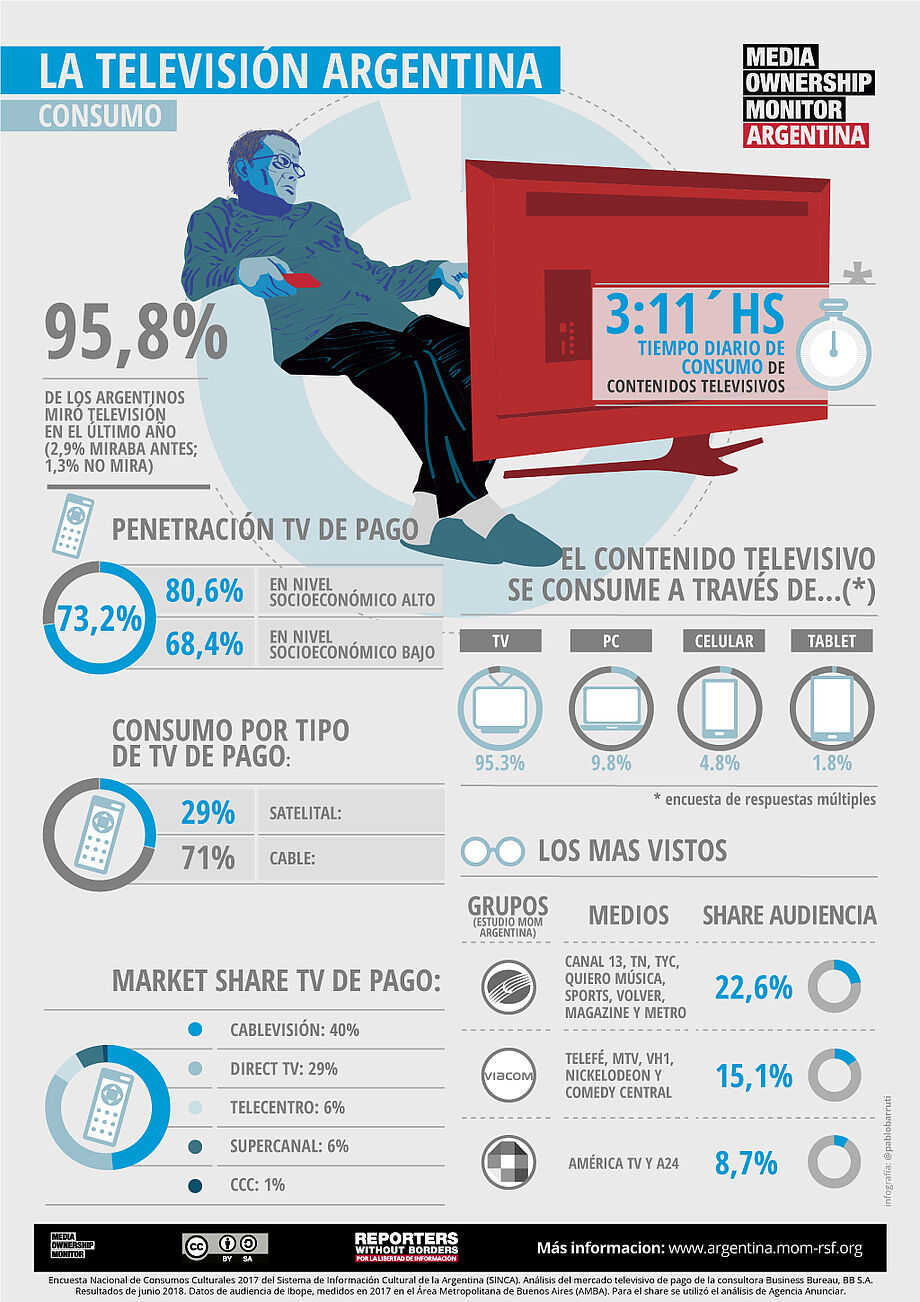Television
To study media ownership concentration, MOM Argentina chose 14 TV signals. These are informative content channels and concentrate the largest market shares. In addition, some of the largest TV channels in big cities in the interior of the country were included. Research efforts focus on the economic groups that own these media outlets, the individuals behind them, the businesses they have in other sectors of the economy and the political ties they keep. The media outlets included in the study are the following:
TV consumption
TV is the most massive medium in Argentina, and consumption is high in all socioeconomic levels and at all rates. Viewers tend to prefer paid TV, which shows a penetration of 78%[2] (including informal connections). This percentage is notably higher than the average in Latin American countries (51%).
Most of the TV content in Argentina is produced in Buenos Aires and offers a centralist view of the country. For instance, all national news bulletins in Argentina show information on the traffic of the city of Buenos Aires and breaking news of the Greater Buenos Aires area. Most of the content that is repeated thousands of kilometers away from the country’s capital city is created in the facilities of Canal Trece (Grupo Clarín) and Telefé (Viacom). Clarín owns eight TV signals across Argentina (including its own signals and managed signals) and several affiliate channels (which broadcast the programming of Grupo Clarín’s signals). Viacom owns eight signals and several repeaters, and is the largest audiovisual content producer in Argentina, with 5,100 hours of content a year.
[1] 2017 National Survey on Cultural Consumption carried out by Argentina’s System of Cultural Information (SINCA).
[2] Market analysis on paid TV in Latin American countries in 2018, carried out by consulting company Business Bureau, BB S.A.
The owners of the audience
The most watched TV channel in Argentina is Telefé, a signal with a family-oriented general programming, always reluctant to show a marked political editorial line. Telefé belongs to international holding Viacom, which concentrates 15.1%[1] of Argentina’s audience.
The second most watched TV channel is Canal Trece, a signal with a general programming that belongs to Grupo Clarín, the media holding that leads audience figures, with a 22.6% market share. TN (Todo Noticias) is Clarín’s leading news channel. Unlike Telefé, Grupo Clarín’s media outlets showed an editorial line that was clearly against Cristina Fernández de Kirchner’s administrations. Cristina Fernández’s sympathizers used to call TN “Todo Negativo” (Everything is bad news) to stress the signal’s biased perspective. Today, TN supports Mauricio Macri’s administration and shows a fierce resistance to kirchnerismo.
The third most watched channel in Argentina belongs to American group Time Warner (Turner-HBO), which includes some of the most popular paid TV channels: TNT Series, Cartoon Network and CNN Internacional. Grupo América, which belongs to three Argentinian businessmen, ranks fourth. Its most relevant media outlets include América TV (the third most watched TV channel in the country) and A24, which grew in audience last year, thus becoming a player in the ratings battle, which has been led by TN and C5N (which belongs to Grupo Indalo, a group close to the Kirchner family).
The fight over soccer TV broadcasting rights
One of the most ambitious businesses in Argentina’s media industry is the broadcasting of national soccer tournaments, as well as the finals of international soccer tournaments featuring Argentinian teams. During these 90-minute events, the streets of Buenos Aires are desert-like, and TV ratings spike.
In fact, the allocation of soccer TV broadcasting rights became one of the most discussed public policies in the last decade. In 2009 the Argentinian Soccer Association (AFA), which owns soccer broadcasting rights, broke the contract it had with companies Televisión Satelital Codificada (TSC) and Torneos y Competencias (where Grupo Clarín holds stock) and reached a new agreement with Argentina’s National Government (led by Cristina Fernández de Kirchner at the time). The Government purchased TV broadcasting rights at $600 million (while TSC had offered $268 to renew its contract). From 2009 to 2016, the games of the professional soccer league (Primera División), the games of the second division (Primera B Nacional) and some finals of international tournaments were broadcast for free on Argentina’s State channel (TV Pública) through the Fútbol para Todos program.
A year after Mauricio Macri’s inauguration, his administration decided to put an end to the agreement with AFA. After a new call for bids, Fox-Turner was granted soccer TV broadcasting rights, and soccer games became a part of paid TV grids once more. Every weekend, two professional soccer league games are broadcast by Fox-Turner (which are included in regular paid TV rates), while the other games can be watched by paying an extra fee.
[1] Ibope Kantar Media in 2017.

















